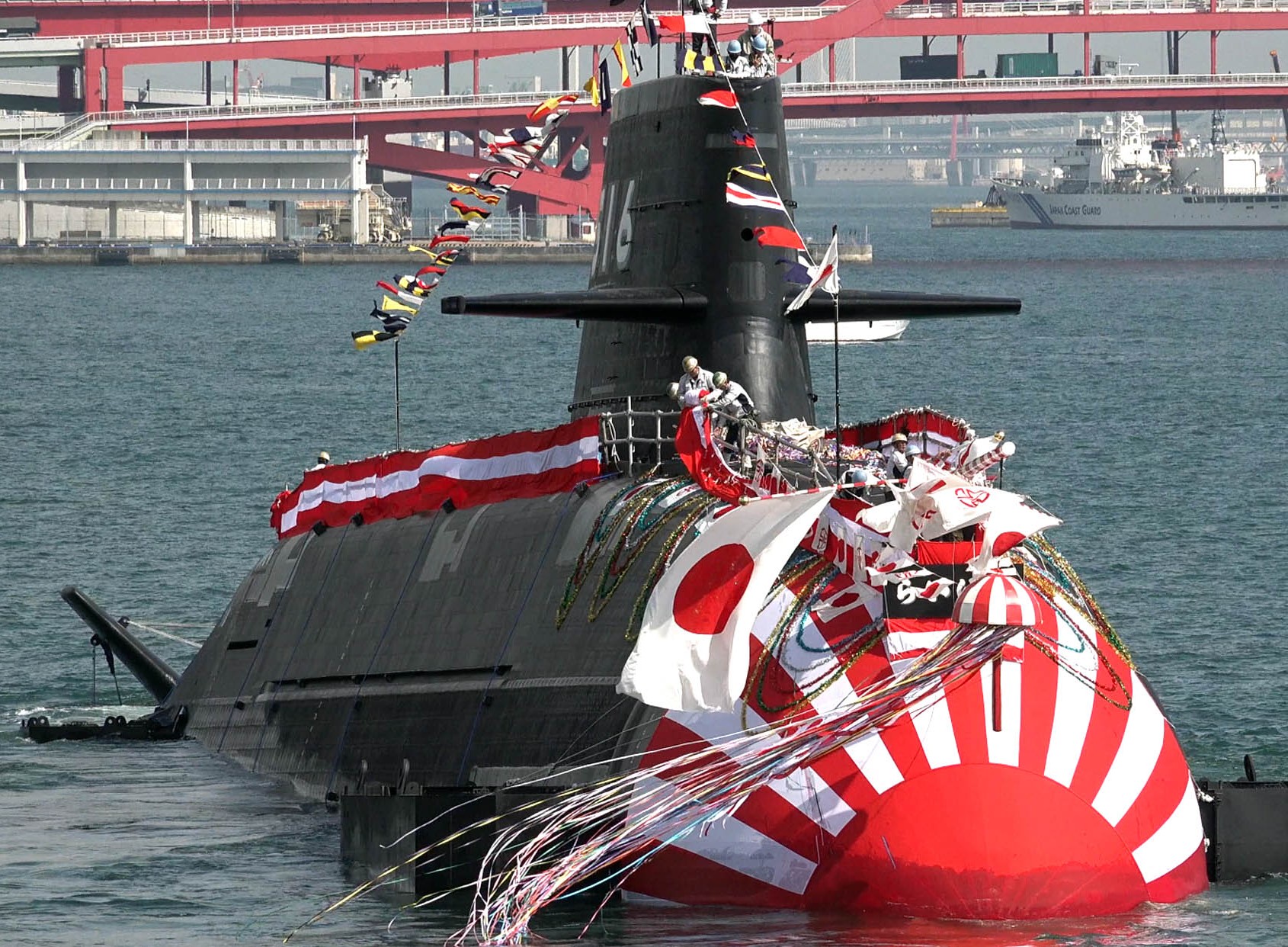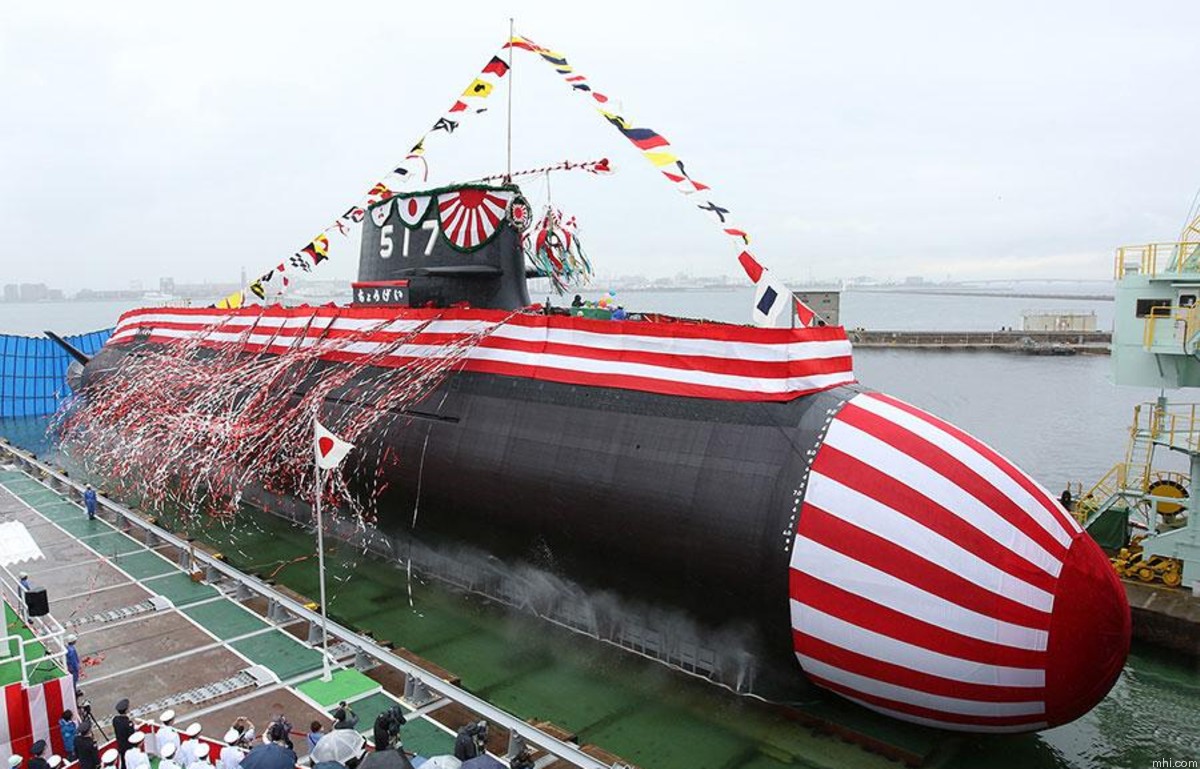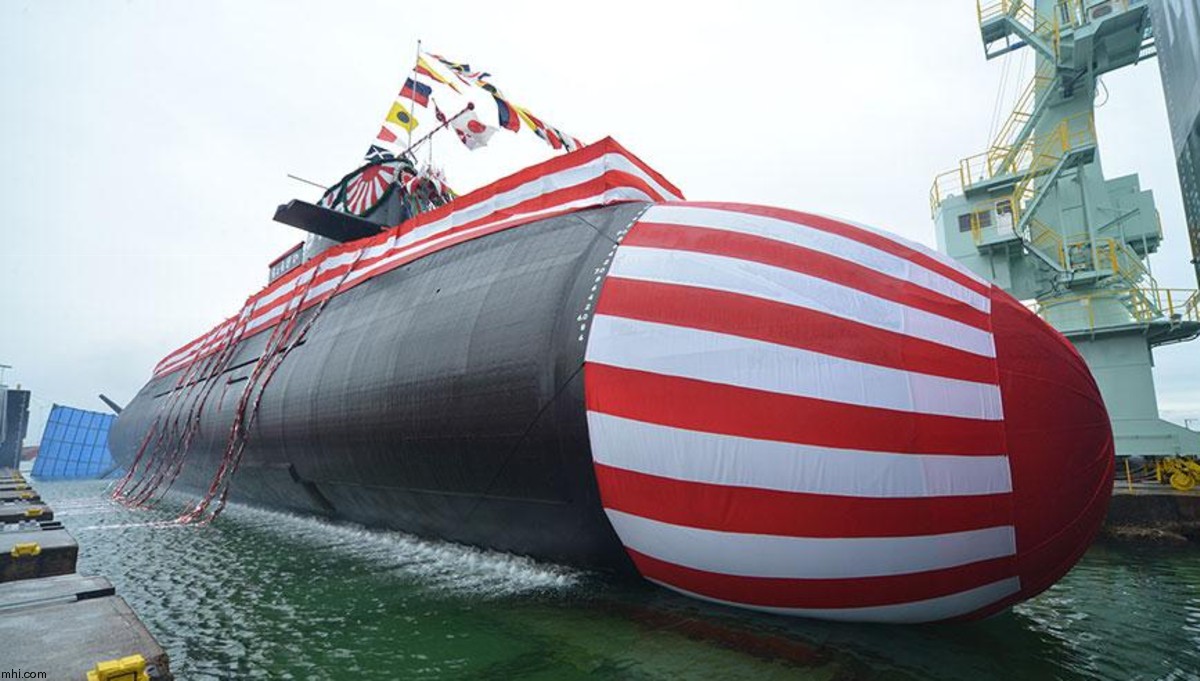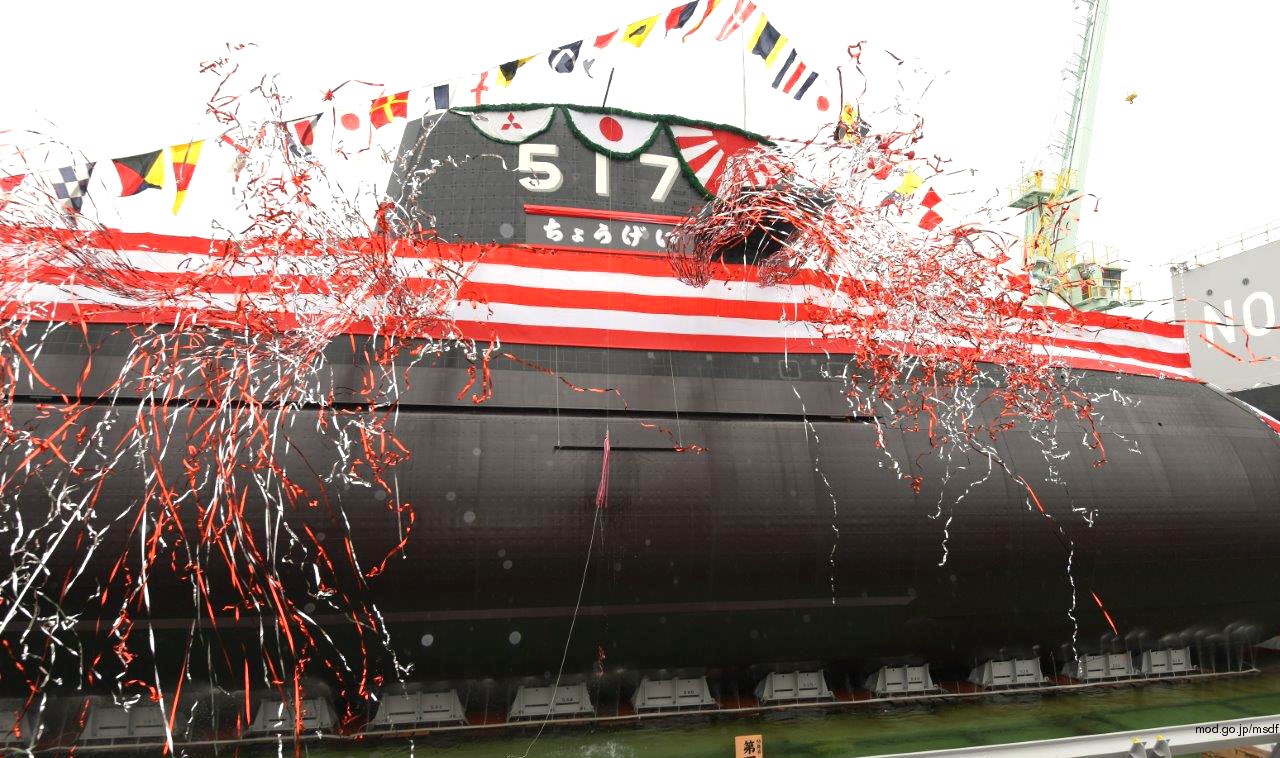 |
|||||||||||||||||||||||||||||||||||||||||||||||||||||||||||||||
|
HOME
|
US Navy -
ships
|
US Navy - air
units
|
USMC - air
units
|
International
Navies
|
Weapon Systems
|
Special Reports |
|||||||||||||||||||||||||||||||||||||||||||||||||||||||||||||||
|
Japan Maritime Self Defense Force / JMSDF Taigei (29SS) class Attack Submarine - SS |
|||||||||||||||||||||||||||||||||||||||||||||||||||||||||||||||
 |
|||||||||||||||||||||||||||||||||||||||||||||||||||||||||||||||
| 10/24 | |||||||||||||||||||||||||||||||||||||||||||||||||||||||||||||||
| Units (8 planned): | |||||||||||||||||||||||||||||||||||||||||||||||||||||||||||||||
|
|||||||||||||||||||||||||||||||||||||||||||||||||||||||||||||||
| Specifications: | |||||||||||||||||||||||||||||||||||||||||||||||||||||||||||||||
|
Builders: Mitsubishi Heavy Industries and Kawasaki Heavy Industries Length: 84 meters (275 feet 7 inches) Beam: 9.1 meters (29 ft 10 in) Draft: 10.4 meters (34 ft 1 in) Displacement: ? tons (submerged) / 3000 tons (surfaced) Speed: 20 knots (37 km/h) Range: ? Complement: 70 Propulsion: DIESEL-ELECTRIC 2 x Kawasaki 12V25/25SB diesel engine (513-515) 2 x Kawasaki 12V25/31 diesel engine (516-520) 6000 hp (4475 kW) 1 shaft / 1 propeller Armament: 6 x HU-606 21-inch (533mm) torpedo tubes for a mix of Type 89 or Type 18 torpedoes UGM-84 Harpoon SSM Systems: C4ISTAR Information Processing System ZQX-12 Submarine Information Management System OYX-1 Submarine Tactical Situation Indicator ZQQ-8 Sonar System ZPS-6H Surface Search and Navigation Radar |
|||||||||||||||||||||||||||||||||||||||||||||||||||||||||||||||
|
|
|||||||||||||||||||||||||||||||||||||||||||||||||||||||||||||||
|
The Taigei-class submarines (29SS) is a new class of attack
submarines developed for the Japan Maritime Self-Defense Force. It
is the successor to the Sōryū-class submarine. Development: The development of the Taigei-class were conducted from a variety of researches aimed at developing new and improved submarine components to improve the capabilities of "next-generation submarines" that will operate in the 2020s and beyond. Early studies (2004): In 2004, an evaluation was made on researching next-generation submarine systems based on capability requirements: dive speed, stealth, etc. The research involves utilizing simulation technologies to optimize the most efficient design for the submarine and analyze its cost-effectiveness. The technical data obtained would be used to aid in the design and construction of the new submarine class. The project reflected that the submarines would be introduced in the 2020s and that the research is conducted between 2005 to 2008, while in-house testing occurs between 2007 to 2009. A total of ¥800 million were used to fund project. In 2005, evaluations for next-generation submarine sonar and Air-independent propulsion (AIP) system were initiated. The first project aims to develop a new sonar array with improvements in weight reduction, power saving and detection ability in response to improved quietness of future ships and submarines. The second projects aims to develop new AIP system to extend underwater sustainability for future submarines. The new sonars are to be introduced to next generation submarines operating from 2020s onward. Likewise, the new AIP systems will allow the submarines to expand their operational areas, including responding in shallow waters. Research on both components were carried out between 2006 to 2008 and tested between 2008 to 2009. A total of ¥1.5 billion and ¥2.5 billion yen were allocated for the sonar and AIP system projects. Future Equipment evaluation (2006): In 2006, an evaluation for anti-detection/shock resistance submarine structure was conducted. The project involves researching propeller and hull shape design to reduce noise generation and submarine structure to improve noise reduction and impact resistance. The research calls for the next-generation submarine make use of floating floor structure; the floorboards are attached to the inner shell through buffer mechanism to prevent vibration inside to submarine from getting out and protect against shock from outside the submarine. A prototype was developed between 2007 to 2011 and tested between 2010 to 2014. A total of ¥400 million were used to fund the project. Power Systems (2009): In 2009, researches on snorkel power generation system and sonar system were evaluated. The new snorkel power generation system aims to be more compact, quiet and generate higher power output to enhance the submarines operability, survivability and stealth. Comparable alternative power generation systems that were examined include the MTU 16V396SE diesel engines used on the Type 212 submarine and SEMT Pielstick PA4V200SM diesel engine. However both engines were deemed to output below required performance and thus the development of a new power generation system was initiated. The sonar system was developed to improve detection and information processing capabilities for next-generation submarines to improve its combat capabilities and operability in shallow waters. The snorkel power generation prototype was developed between 2010 to 2014 and tested between 2014 to 2015. The prototype for the sonar system was developed between 2010 to 2013 and tested between 2013 to 2014. A total of ¥1.3 billion were allocated to fund the snorkel power generation system project and ¥4.9 billion for the sonar system. Structure and Hull (2012): In 2012, research on the structural mode for submarines was conducted. Typically when adding new equipment onto an existing submarine design the solution to integrate it is to extend the compartment length of the submarine; which in turn increases the size, reinforcing of materials and price. The purpose of the research is to reduce future submarine size and price by optimizing the structural mode of the pressure shell of a submarine and obtain technical data to develop future submarine design. A research prototype was developed between 2013 to 2015 and in-house testing were conducted between 2014 to 2015. A total of ¥1.1 billion were used to fund the research. In 2016, proposed research on new hull design to reduce fluid noise and a new sonar system to cope with the quietness of future foreign ships and submarines were evaluated. The research into the reduction of fluid noise will implement technologies to reduce interference noise from the hull and propellant and reduce low frequency noise components caused by the interference generated between the flow around the hull and the propellant. The evaluation into the new sonar system expects that foreign surface ships and submarines operating in the 2030's will improve their quietness and operate in complex and diverse marine environments; thus improvements in detection and tracking capabilities were researched. The first research was commenced between 2017 to 2020, while testing occurs between 2019 to 2022. Development of a new sonar system is researched between 2017 to 2020, followed by immediate testing in 2020. A total of ¥1.2 billion were used to research the new hull design, while ¥5.1 billion were used to research the sonar system. Silent Drive and Power Storage (2017): In 2017, research on a silent drive system was evaluated. The silent drive system is used to further reduce the noise emitted from the submarine en-light of improvements made in sonar technology from other countries. Research is conducted between 2018 to 2021 and will be tested between 2021 to 2022. A total of ¥5.7 billion were allocated for this project. In 2018, an evaluation on a high-efficiency power storage and supply system was conducted. The project aims to improve the efficiency and energy of the power storage and supply system by achieving high efficiency and miniaturization in the power supply system and increasing the capacity and density of the power storage system. Prototyping occurs between 2019 to 2022 and in-house testing to simulate the installation on a submarine occurs in 2023. A total of ¥4.4 billion are used in its development. Design: The hull design of the Taigei-class is said to not differ too much from the Sōryū-class but will be 100 tons heavier than its predecessor. However, the Taigei-class submarines will be more advanced as they are equipped with newer equipment such as sonar systems, snorkel power generation system. The 'Taigei-class will use lithium-ion batteries much like the JS Ōryū and JS Tōryū submarines. The submarine will likely use the Type 18 torpedo, which project name as "G-RX6". Operational use: The first submarine of this class, Taigei, will be converted to a test submarine. The reason for the change is due to the need to acquire a dedicated test submarine instead of pulling an ordinary submarine from its operations to conduct tests. By doing so, the JMSDF can increase operating days and strengthen monitoring activities with their attack submarines while the test submarine will accelerate research and development. source: wikipedia (12/20) |
|||||||||||||||||||||||||||||||||||||||||||||||||||||||||||||||
| images | |||||||||||||||||||||||||||||||||||||||||||||||||||||||||||||||
 SS-513 JS Taigei  SS-513 JS Taigei  SS-513 JS Taigei  SS-513 JS Taigei  SS-513 JS Taigei  SS-513 JS Taigei  SS-513 JS Taigei  SS-513 JS Taigei  SS-513 JS Taigei  SS-513 JS Taigei  SS-513 JS Taigei  SS-513 JS Taigei  SS-513 JS Taigei  SS-513 JS Taigei  SS-513 JS Taigei  SS-513 JS Taigei  SS-513 JS Taigei  SS-513 JS Taigei  SS-513 JS Taigei  SS-513 JS Taigei  SS-514 JS Hakugei  SS-514 JS Hakugei  SS-514 JS Hakugei  SS-514 JS Hakugei  SS-514 JS Hakugei  SS-514 JS Hakugei  SS-514 JS Hakugei  SS-515 JS Jingei  SS-515 JS Jingei  SS-515 JS Jingei  SS-515 JS Jingei  SS-515 JS Jingei  SS-515 JS Jingei  SS-515 JS Jingei  SS-515 JS Jingei  SS-515 JS Jingei  SS-515 JS Jingei  SS-515 JS Jingei  SS-516 JS Raigei  SS-516 JS Raigei  SS-516 JS Raigei  SS-517 JS Chogei  SS-517 JS Chogei  SS-517 JS Chogei UNIDENTIFIED BOATS        |
|||||||||||||||||||||||||||||||||||||||||||||||||||||||||||||||
|
|
seaforces.org
|
Japan Maritime Self Defense Force start page
| |